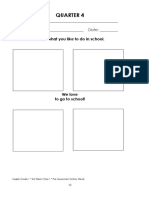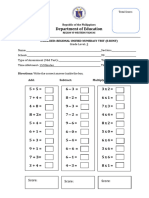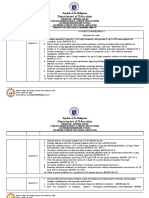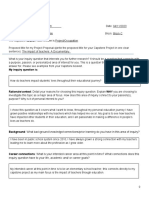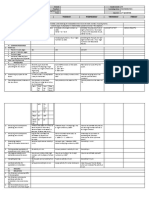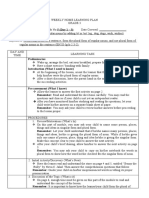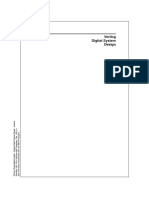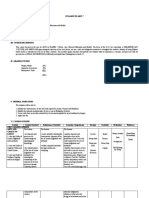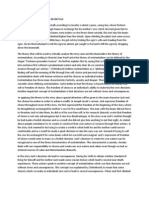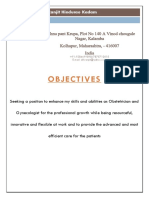Action Research in Numeracy
Action Research in Numeracy
Uploaded by
Juanito ViceraCopyright:
Available Formats
Action Research in Numeracy
Action Research in Numeracy
Uploaded by
Juanito ViceraCopyright
Available Formats
Share this document
Did you find this document useful?
Is this content inappropriate?
Copyright:
Available Formats
Action Research in Numeracy
Action Research in Numeracy
Uploaded by
Juanito ViceraCopyright:
Available Formats
13th National Convention on Statistics (NCS) EDSA Shangri-La Hotel,
Mandaluyong City October 3-4, 2016
DEVELOPING THE PERFORMANCE OF GRADE III -ARMSTRONG PUPILS OF
MALAGASANG III ELEMENTARY SCHOOL USING COMPUTATIONAL SKILLS,
MULTIPLICATION DRILL CARD AND MASTERING IT
by Juanito P. Vicera
ABSTRACT
The action research aims to develop more the performance of
Grade III- Armstrong Pupils in Mathematics in Malagasang III
Elementary School computational skills and multiplication card drill.
Specifically, the action research focus to: 1) use computational
skills to enhance the mastery level of Grade III-Armstrong in
Mathematics, 2) enhance comprehension skills of Grade 3 on
Mathematics concepts using multiplication drill card 3)to motivate
and sustain pupils’ interest in Mathematics and 4) improve the
teaching strategy in Mathematics using computational skills and
multiplication card drill. The study was conducted for two quarters
from June-October 2015(1st and 2nd Grading) with 35 pupils as the
target subjects. The study used experimental design to look into the
effectiveness of computational skills and multiplication caerd drill
in improving pupils’ performance in Mathematics. The findings showed
that the use of Arts In Math (AIM) enhanced the performance of Grade
III-Armstrong Pupils in Mathematics. For the first quarter, there was
an increase of 34.13 in the MPS and 29.79 for the second quarter.
Using the t-test of the difference between means of correlated data,
the t- test computed value of 23.71 for the first quarter and 32.37
for the second quarter is more than the critical value of 1.676 at
0.05 level of significance with 45 degrees of freedom.
In conclusion, Arts In Math (AIM) enhanced mastery learning
and comprehension of Grade 6-C pupils based from the pretest and
posttest. There was a significant difference between the means of
pretest and posttest using t-test as the statistical treatment. In
addition, Arts in Math (AIM) stimulated, motivated and sustained
pupils’ interest. Furthermore, Arts In Math (AIM) improved the
teaching strategy in Mathematics. As to the recommendations, teachers
should be encouraged and motivated to use Arts In Math so as to
enhance pupils’ performance in Math. Moreover, integration of arts
should not only be used in teaching Mathematics but also with other
subjects. The school head should encourage and support the generation
and use of the Arts In Math (AIM). I.
INTRODUCTION The world today is undergoing a tremendous change
which causes a chain of problems and challenges to mankind. Man is
endowed with intelligence and is making use of his ingenuity to
wrestle with these brain-pain problems not only to cope with and be
attuned with the changing times but most especially to survive.
Mathematics is one of those disciplines greatly influenced by the
process of change in our world today. In the words of Adler,
Mathematics is the handmaiden of science, is also the art which
expresses beauty through a system of definitions, axioms and
theorems. It is one of the most important tools man has forged in his
quest to understand and control his environment. Since Mathematics is
an indispensable tool for technological age, it is the role of
mathematics teachers to provide opportunities to pupils to learn
materials which may be considered new or modern. Page 3 of 9 Most
failure in Mathematics is due to the sole memorization with devoid
understanding. Pupils lack the application of skills and techniques
which help the pupils develop their critical thinking, reasoning
power and creative minds which they use in working independently in
any kind of Mathematics activities. It was observed that pupils
easily get bored in solving pure numbers during their Math period.
They enjoy more in their ARTS subject which has something to do with
drawing and coloring pictures. They are more behaved in doing their
arts activities independently. In Buyagan Elementary School,
Mathematics had been noted as one of the most difficult subject since
it consists of a collection of facts and skills to be memorized or
mastered by a relatively heterogeneous group of pupils. The result of
the National Achievement Test (NAT) in Mathematics in the year 2013
is 66 .32 % and in the year 2014 is 68.82%. Though it shows that it
is increasing, it did not yet reach the 75% standard level. The
researcher in her role as a Mathematics teacher concerned herself on
how to help the pupils perform better in the field of Mathematics.
This concern made the researcher planned to find possible solutions
that could assist the Grade Six Section C pupils of Buyagan
Elementary School in enhancing their level of performance in
Mathematics. II. METHODOLOGY The researcher used ARTS IN MATH (AIM)
as a strategy that would enhance the performance of Grade VI Section
C pupils of Buyagan Elementary School in Mathematics during the
school year 2015-2016. Arts in Math (AIM) is an excellent strategy.
This makes use of instructional approaches which attempts to make the
process of learning mathematics more enjoyable, more exciting and
more meaningful. It significantly improves mastery of key concepts
and vocabulary. It helps the pupils relax and reduce the stress which
many of the pupil’s experience as a result of Math anxiety.
According to John Malkevitch (2012) in his Mathematics and Art
feature Column from the AMS, all students are gifted and using arts
in math gives artistically gifted children a chance to shine. For
right-brained children (who are often left-handed), art engages the
right brain which is a critical part of their ability to learn math
concepts and vocabulary. In addition to this benefit- art activities
are fun for everybody, and since authentic learning is linked to
emotion, it makes sense to incorporate art whenever possible in
teaching Math. Arts In Math (AIM) calls for simple and direct
instruction that aims to help pupils memorize fundamental
mathematical concepts while having arts. The pupils can use colors
and shapes to enhance their understanding of Math. The materials are
in the form of activity sheets that will be used inside the classroom
and are used in selected topics. The pupils will answer or solve
mathematics sentences before they are going to perform art activities
like coloring or painting. Here are the activities and lesson ideas
using Arts in Math: Color My Petals : Make the petals of the
flower colorful by applying different colors but the pupils will have
to add and subtract decimal numbers first. Page 4 of 9 My Cutie
Puppy : This activity focuses on multiplying decimals by 0.1,0.01 and
0.001. The pupils will find the product and color the parts of the
puppy according to the given codes. Answer, Find and Color: This
activity is about multiplication of decimals. The pupils are going to
answer the given numbers, find the product and color the picture
according to the given codes. Solve, Find and Shade: These
activities cover division of decimals. The pupils are going to solve,
find the quotient and shade the parts of each drawing according to
the given codes. Funny Tweety: This activity is an enjoyable and
interesting way to identify prime and composite numbers. My Chubby
Pooh : This activity is on identifying equivalent fractions. The
pupils are task to find the fractions equivalent to the given set of
fractions before applying colors on Pooh’s clothes. Treasure
Hunting: It focuses on determining and matching the GCF of 2 numbers
placed below the miners’ carts and the gold bars. Food Delivery
Maze: It requires the pupils to change the fractions to decimals
until they will reach grandma’s house and delivers the food. III.
RESULT AND DISCUSSION Arts in Math (AIM) was used in the teaching-
learning process for the first and second quarters of the school year
2015-2016 to enhance the performance in Mathematics of the Grade 6
section C pupils of Buyagan Elementary School. Different activities
using Arts in Math were used in the development of lessons as well as
during the preparatory activities and evaluation activities. The
researcher used Arts in Math (AIM) in almost all the least learned
competencies in Mathematics. The result of the teaching-learning
process is presented basing on each objective. They are as follows:
A. Effectiveness of Arts in Math (AIM) in enhancing the mastery
learning of Grade 6-C pupils in Mathematics Arts in Math (AIM)
particularly the use of drawing, coloring, painting, and etching
activities in teaching the competencies enhanced the learning of the
Grade 6-C pupils in Mathematics. During the teaching of Mathematics,
different individual and group activities were used to add, subtract,
multiply, divide decimals, identify prime and composite numbers, find
equivalent fractions, determine GCF and LCM, change fractions to
lowest terms, reduced fractions, add, subtract, multiply and divide
similar and dissimilar fractions. Table 1 shows the pretest and
posttest results for the two quarters- first quarter and second
quarter. Results show that there was an increase of 34.13 in the MPS
for the first quarter and 29.79 for the second quarter. The increase
in the mean score which indicated great difference between the
pretest and posttest evidently validated the claim that pupils
exposed to creative, exciting and varied activities had better
retention and had mastered the lessons. Table 1 also presents the
results of the t-test statistics between the pretest and posttest for
the first quarter and second quarter. Page 5 of 9 Using the t-test of
the difference between means of correlated data, the t- test computed
value of 23.71 for the first quarter and 32.37 for the second quarter
is more than the critical value of 1.676 at 0.05 level of
significance with 45 degrees of freedom. The result shows that Arts
In Math (AIM) is an effective tool in improving learning in
Mathematics. Table 1: Mean Difference of the Pre-test and Post Test
score in AIM Quarter Test Mean Standard Deviation Computed t df
Tabulated value of t at 0.05 level of significance 1 st Pre-test
14.57 4.86 23.71 45 1.676 Post test 31.63 2 nd Pre-test 16.02 3.15
32.37 45 1.676 Post-test 30.91 B. Improved comprehension skills of
Grade 6 on Mathematics concepts through the use of Arts In Math (AIM)
Using Arts In Math (AIM) in teaching Mathematics showed that there
was an improvement on the comprehension skills of the pupils on
Mathematics concept. Individual and group arts activities in the
development of the lessons, lesson proper and during the evaluation
of learning outcomes were used. Table 2 presents the mastery indices
of the different competencies for the first grading examination. It
could be seen that most of the competencies are under Closely
Approximating Mastery (CAM) and Mastered (M). Of the 15 competencies,
six (6) were under Mastered (M) and nine (9) were under Closely
Approximating Mastery. This could be attributed from the effect of
the Arts in Math (AIM) used in classroom instruction. Table 2:
Mastery Index per Competency in Math 6 First Grading Examination
COMPETENCIES Average Number. of Correct Responses Percentage of
Correct Responses Mastery Level 1. Translate word phrase to numerical
expressions. 43 93% CAM 2. Write correct equation for a
problem/situation. 40 87% CAM 3. Evaluate an expression with/without
exponents. 40 87% CAM 4. Identify the value/place value of a digit in
a given decimal. 41 89% CAM 5. Compare and order decimals through ten
thousandths. 43 93% CAM 6. Estimate sums and differences of whole
numbers and decimals. 40 87% CAM 7. Add and subtract whole numbers
and decimals. 46 100% M 8. Solve 2 to 3 step word problems involving
addition and subtraction of decimals. 44 96% M 9. Multiply whole
numbers and decimals. 44 96% M Page 6 of 9 10. Multiply decimals by
10,100, 1000. 46 100% M 11. Multiply decimals by 0.1,0.01,0.001. 46
100% M 12. Solve 1- to 3- digit by 1- to 2-digit factors of decimals
and numbers with zero difficulty. 44 96% M 13. Solve word problems
involving whole numbers and decimals including money. 43 93% CAM 14.
Estimate quotients of whole numbers and decimals. 38 83% CAM 15.
Divide 2- to 5- digit whole numbers by 1- to 2- digit decimals. 38
83% CAM M- Mastery CAM- Closely Approximating Mastery Table 3
presents the mastery indices of the different competencies for the
second grading examination. Of the 19 competencies, four (4) were
under Mastered (M), fourteen (14) were under Closely Approximating
Mastery (CAM) and one (1) was under Moving Towards Mastery (MTM).
Table 3: Mastery Index per Competency in Math 6 Second Grading
Examination Competencies Ave. No. of Correct Responses Percentage of
Correct Responses Mastery Level 1 .Divide whole numbers by 1-to 2-
digit decimals. 39 85% CAM 2. Divide a whole number by decimal and
mixed decimal 38 83% CAM 3. Divide mixed decimals by mixed decimals.
36 78% MTM 4. Divide decimals by 10, 100, 1000,0.1,0.01.and0.001 43
93% CAM 5. Solve word problem involving division of decimals
including money 38 83% CAM 6. Identify prime and composite numbers 46
100% M 7. Determine the greatest common factor(GCF)of 2 or more
numbers 40 87% CAM 8. Determine the least common multiple(LCM)of 2 or
more numbers. 40 87% CAM 9. Rename fractions as decimals and vice
versa 39 85% CAM 10.Reduce fractions to lowest term. 42 91% CAM
11.Change mixed numbers to improper fraction or vice versa. 44 96% M
12.Estimate fractions close to 0,1/2, or 1 38 83% CAM 13.Find the
least common denominator(LCD) of a set of numbers. 43 93% CAM
14.Order fractions in simple or mixed forms in ascending or
descending order. 46 100% M 15.Add similar fractions in simple or
mixed form with regrouping. Competencies 44 96% M 16. Subtract
similar fractions in simple and mixed forms with or without
regrouping. 41 89% CAM 17. Add dissimilar fractions with or without
regrouping. 40 87% CAM 18. Subtract dissimilar fractions with or
without regrouping. 40 87% CAM Page 7 of 9 19. Analyze and solve 1-to
2- step word problems involving addition or subtraction of fractions
in simple or mixed forms with or without regrouping. 38 83% CAM M-
Mastery CAM-Closely Approximating Mastery MTM-Moving Towards
Mastery C. Used Arts In Math (AIM) to stimulate, motivate and sustain
pupils’ interest The study used different arts activities in
teaching Mathematics 6. Coloring activities for individual work and
group work were used. Aside from coloring activities, painting,
colored paper tearing, sprinkling, cutting and crayon etching were
also done. According to Larrick (1953) as cited by Agnasi (2013),
there is no substitute for the study of the interest of the
individual; we must make the most of the children’s interest because
it is the starting point for the improvement, a barometer of
proficiency and as a criterion of the success of school instruction.
It was observed that whenever the lessons were presented using Arts
In Math (AIM), the pupils became more interested and active in all
the activities. Pupils’ interest throughout the teaching-learning
process was very evident. Table 4 presents the attendance of the
pupils for the first and second quarters. Results show that there
were 100% of attendance from the beginning of classes up to the end
of the first semester (June-October) and no pupils were tardy or late
in their Mathematics subject. Table 4: Attendance of Pupils for the
1st and 2nd Quarters 1 st Quarter 2 nd Quarter Male Female Total Male
Female Total No. of Pupils 22 24 46 22 24 46 Average Attendance 22 24
46 22 24 46 Percentage of Attendance 100% 100% 100% 99% 100% 100%
Number of pupils tardy/late 0 0 0 0 0 0 D. Improved the teaching
strategy in Mathematics According to Rivera and Sambrano (1982), as
cited by Ducayso (2004), the slow learners have short span of
interest; hence, they exactly get bored. Because of this, the teacher
should set more interesting environment through discussions, games,
puzzles, arts and other exciting activities. It is then the role of a
teacher to make the teaching-learning process effective and
successful by improving his teaching strategy instead of typical
intermediate papers or chalk boards. The use of Arts In Math (AIM)
was a very effective strategy in teaching Mathematics subject. The
pupils were provided with different art activities which they enjoyed
doing while computing and analyzing mathematical sentences and
mathematics word problems. Page 8 of 9 IV. CONCLUSION From the
findings, the researcher came up with the following conclusions: 1.
Arts In Math (AIM) enhanced mastery learning and comprehension of
Grade 6-C pupils based from the pretest and posttest. There was a
significant difference between the means of pretest and posttest
using t-test as the statistical treatment. 2. Arts in Math (AIM)
stimulated, motivated and sustained pupils’ interest. 3. Arts In
Math (AIM) improved the teaching strategy in Mathematics. V.
RECOMMENDATIONS Based on the findings and the conclusions drawn from
the study, the following recommendations are given: 1. Teachers
should be encouraged and motivated to use Arts In Math so as to
enhance pupils’ performance in Math. 2. Integration of Arts should
not only be used in teaching Mathematics but also with other
subjects. 3. The school head should encourage and support the
generation and use of the Arts In Math (AIM). VI. REFLECTION Every
teacher wants their pupils to learn, to shine and to excel in their
classes. Every teacher believes that the success of the learners
reflects the success of his way of imparting knowledge to them.
Different strategies are being used to ensure that every learner will
be able to learn. In this study, Arts In Math (AIM) was used to make
teaching-learning process in Mathematics fun, enjoyable and
interesting. At first, it was a tough job for me since I didn’t have
the skills in arts, but I really wanted to present and teach math
concepts in a way that pupils will develop the attitude of “I LOVE
MATH.” With the saying-“If there’s a will, there’s a way,” I was
able to produce different art activities for my pupils even it
entailed a lot of hard work and consumed most of my time.
Nevertheless, I find contentment when I saw my pupils humming and
smiling while doing their individual or group work activites. With
this research, I realized that a teacher should be ARTISTIC. A
teacher should possess the following characteristics: A= Artistic and
Approachable R= Resourceful T= Thoughtful I= Innovative S= Systematic
T= Tender to his/her pupils I= Ingenious C= Creative Page 9 of
You might also like
- New Generation Korean Beginner LevelDocument222 pagesNew Generation Korean Beginner LevelAlena Kuzmina100% (3)
- A Lesson Plan in Adding and Subtracting Integers Using Algebra TilesDocument4 pagesA Lesson Plan in Adding and Subtracting Integers Using Algebra TilesLesley NoreenNo ratings yet
- Building and Managing An Effective Project Team: Steven R. MeierDocument4 pagesBuilding and Managing An Effective Project Team: Steven R. MeierahmedNo ratings yet
- Action ResearchDocument8 pagesAction ResearchAiryn MonterdeNo ratings yet
- Cot1 Math-Ordinal NumbersDocument2 pagesCot1 Math-Ordinal NumbersGonie HabanaNo ratings yet
- English 3 WHLP Q1 Module 10Document2 pagesEnglish 3 WHLP Q1 Module 10RM Batulan100% (1)
- ACR ON Determining Learners Level of NumeracyDocument4 pagesACR ON Determining Learners Level of NumeracyJennifer SayongNo ratings yet
- Math 4 - Week 6Document50 pagesMath 4 - Week 6Teacher Ian100% (1)
- LG MATH Grade 5 - Graphs - Line Graph v2.0Document23 pagesLG MATH Grade 5 - Graphs - Line Graph v2.0Levi Corral100% (1)
- 1ST COT-MATH 2 - Q3 Week 7Document8 pages1ST COT-MATH 2 - Q3 Week 7Ma. Ellaine Grace BecaroNo ratings yet
- Learning Activity Sheet Math 5 - Problem Solving (Fractions)Document12 pagesLearning Activity Sheet Math 5 - Problem Solving (Fractions)Danny LineNo ratings yet
- Grade 1 LM English Quarter 4Document19 pagesGrade 1 LM English Quarter 4Jade GarcillanNo ratings yet
- Diagnostic Test Grade 3 q3Document9 pagesDiagnostic Test Grade 3 q3Jeanylyn DiamanteNo ratings yet
- FINAL MidTest E RUNT Grades 3Document1 pageFINAL MidTest E RUNT Grades 3lorevic dalumpines100% (2)
- Mathematics 1 - Q4 - W4 DLLDocument5 pagesMathematics 1 - Q4 - W4 DLLNes ConstanteNo ratings yet
- Session 1: Early Language Literacy and Numeracy: Pre-TestDocument40 pagesSession 1: Early Language Literacy and Numeracy: Pre-TestGly Pascual Asuncion100% (1)
- Learning Intervention For Non-NumeratesDocument2 pagesLearning Intervention For Non-NumeratesAmicoPerlas100% (1)
- Classroom Action PlanDocument2 pagesClassroom Action PlanBREZA LOGRONONo ratings yet
- MATH 5 DLL - Q1 Shows That Multiplying A Fraction by Its Reciprocal Is Equal To 1Document5 pagesMATH 5 DLL - Q1 Shows That Multiplying A Fraction by Its Reciprocal Is Equal To 1Mary Ann Pontillas100% (1)
- Co3 Identifying Percentage Base and RateDocument7 pagesCo3 Identifying Percentage Base and RateAngelbert NavasNo ratings yet
- Week 6 - Grade 3 at HomeDocument4 pagesWeek 6 - Grade 3 at Homeapi-506381744No ratings yet
- Math 5 ReviewerDocument4 pagesMath 5 ReviewerLuche100% (1)
- Assessment Tools - NumeRO DAPATDocument9 pagesAssessment Tools - NumeRO DAPATmaellengotgotao295No ratings yet
- DLL - Mathematics 5 - Q4 - W4Document7 pagesDLL - Mathematics 5 - Q4 - W4Yvonnie LagahitNo ratings yet
- The Whats Whys and Hows of Mathematical InvestigationDocument35 pagesThe Whats Whys and Hows of Mathematical InvestigationMa. Angelica Bautista100% (1)
- Grade 1&2 - Yanga - Math 1st Quarter COTDocument4 pagesGrade 1&2 - Yanga - Math 1st Quarter COTMa. Linda Yanga100% (1)
- MATH 4 10 Least LearnedDocument3 pagesMATH 4 10 Least Learnedariel mateo mones100% (1)
- Math 6 DLP 69 - Ordering Integers in Increasing or Decreasing OrderDocument11 pagesMath 6 DLP 69 - Ordering Integers in Increasing or Decreasing Orderlk venturaNo ratings yet
- LeaP Math G6 Week 7 Q3Document4 pagesLeaP Math G6 Week 7 Q3Akira Hector NorthNo ratings yet
- Capstone Project ProposalDocument5 pagesCapstone Project Proposalapi-654571590No ratings yet
- DLL - Mathematics 3 - Q2 - W4Document3 pagesDLL - Mathematics 3 - Q2 - W4April ToledanoNo ratings yet
- English 3 WHLP Q1 Module 7Document2 pagesEnglish 3 WHLP Q1 Module 7RM BatulanNo ratings yet
- HG 6 Q2 Week 7 01 04 06 2023Document12 pagesHG 6 Q2 Week 7 01 04 06 2023Mary Grace ContrerasNo ratings yet
- MELC With ChecklistDocument31 pagesMELC With ChecklistMakRo Dax100% (1)
- 21st Century Techniques and Pedagogies in MathematicsDocument39 pages21st Century Techniques and Pedagogies in MathematicsNathalie CordialNo ratings yet
- 2nd Grading Mathematics Grade VIDocument70 pages2nd Grading Mathematics Grade VIsweetienasexypaNo ratings yet
- 4 - PG-DLL-Homeroom-Guidance4-Q1-W5Document3 pages4 - PG-DLL-Homeroom-Guidance4-Q1-W5Perla GabrielNo ratings yet
- Sip Annex 2b Child Protection Policy Implementation ChecklistDocument2 pagesSip Annex 2b Child Protection Policy Implementation ChecklistGIOVANNE S APOSTOL100% (1)
- Math DLLDocument36 pagesMath DLLHendrix VivencioNo ratings yet
- Table of Specification in Mathematics Vi First Periodical Test S.Y. 2017-2018Document13 pagesTable of Specification in Mathematics Vi First Periodical Test S.Y. 2017-2018Angelica DionisioNo ratings yet
- Minutes of The Meeting (Wipes) 2Document3 pagesMinutes of The Meeting (Wipes) 2Meramae Arreglo VargasNo ratings yet
- Cot Math 4Document5 pagesCot Math 4Gerald LosanesNo ratings yet
- Elimination Round Math Quiz Bee For PrintingDocument2 pagesElimination Round Math Quiz Bee For PrintingMark DagmanteNo ratings yet
- RM No. NCR 185 S. 2021 Learning Assurance For Monitoring and Progress Mid Year and Year Exit AssessmentDocument26 pagesRM No. NCR 185 S. 2021 Learning Assurance For Monitoring and Progress Mid Year and Year Exit AssessmentNickBlaireNo ratings yet
- Sample IDLAR 1 1Document3 pagesSample IDLAR 1 1teacherkloydNo ratings yet
- Cot2 Math5Document5 pagesCot2 Math5Marky DivNo ratings yet
- Idm Narrative ReportDocument3 pagesIdm Narrative ReportALMERA MEJORADA100% (1)
- DLP MathQ1Document19 pagesDLP MathQ1Music LoverNo ratings yet
- Grade 4 Math PelcDocument4 pagesGrade 4 Math PelcRonan Sibbaluca100% (2)
- MATH 6 WEEK 5 DAY 1 Word Problems Involving Finding The Percent of Increase Decrease On Discounts, Original Price, Rate of Discount, Sale Price, and Mark Up PriceDocument27 pagesMATH 6 WEEK 5 DAY 1 Word Problems Involving Finding The Percent of Increase Decrease On Discounts, Original Price, Rate of Discount, Sale Price, and Mark Up PriceMyrrh Estela RamirezNo ratings yet
- Department of EducationDocument3 pagesDepartment of EducationRandix RANo ratings yet
- DLL Mathematics 4 q3 w1Document4 pagesDLL Mathematics 4 q3 w1YolydeBelenNo ratings yet
- 2ND Quarter WEEK 7Document16 pages2ND Quarter WEEK 7Nhel CillanNo ratings yet
- English: Quarter 3: Week 7 Learning Activity SheetsDocument8 pagesEnglish: Quarter 3: Week 7 Learning Activity SheetsPhoebe Dayrit Cunanan100% (1)
- Friday-catch-up-lesson-plan-in-MATH-4 Feb. 16Document2 pagesFriday-catch-up-lesson-plan-in-MATH-4 Feb. 16Amhik AlimpuyoNo ratings yet
- Lac SG 4 Primals 7 10 RevisedDocument14 pagesLac SG 4 Primals 7 10 RevisedAlleli Faith Leyritana100% (1)
- National Mathematics ProgramDocument7 pagesNational Mathematics ProgramCathy MclouzeNo ratings yet
- Activity Sheet 2 Q2 Week 2 EnglishDocument3 pagesActivity Sheet 2 Q2 Week 2 EnglishMargie Macam RodriguezNo ratings yet
- COT1ST Math 5Document3 pagesCOT1ST Math 5Sheryl EbitnerNo ratings yet
- Table of Specification Mathematics Ii Second QuarterDocument2 pagesTable of Specification Mathematics Ii Second QuarterDaizylie Fuerte100% (1)
- Elementary School ‘Grades 1 & 2: Math – Number – Ages 6-8’ eBookFrom EverandElementary School ‘Grades 1 & 2: Math – Number – Ages 6-8’ eBookNo ratings yet
- Grade 2 English Endterm 1 Exam 2024Document3 pagesGrade 2 English Endterm 1 Exam 2024brightent254No ratings yet
- Prospectus 2023-24Document6 pagesProspectus 2023-24MIZAN INDNo ratings yet
- CBSE Class 5 Mental Maths Patterns WorksheetDocument2 pagesCBSE Class 5 Mental Maths Patterns WorksheetHimanshu GoelNo ratings yet
- Systema and Tai Chi ChuanDocument4 pagesSystema and Tai Chi ChuanTomas Mascaro100% (1)
- Verilog Digital Systems Design (Navabi)Document477 pagesVerilog Digital Systems Design (Navabi)Martin PacckerNo ratings yet
- Bill Gates Speech at HarvardDocument2 pagesBill Gates Speech at HarvardLupita Gaona JacoboNo ratings yet
- Grade 7 ARTSDocument6 pagesGrade 7 ARTSrose ynqueNo ratings yet
- Assessment TechnologyDocument8 pagesAssessment Technologyapi-279828600No ratings yet
- Project: Lesson Plan Based On The ASSURE ModelDocument5 pagesProject: Lesson Plan Based On The ASSURE ModelRuba Tarshne :)No ratings yet
- Blended Learning Lesson PlanDocument6 pagesBlended Learning Lesson Planapi-549379562No ratings yet
- Critical LensDocument2 pagesCritical LensKymbali BryantNo ratings yet
- Edmond LPDocument7 pagesEdmond LPEdmond BajadoNo ratings yet
- Portfolio Activity Unit 1 EDUC 5220Document7 pagesPortfolio Activity Unit 1 EDUC 5220DanaNo ratings yet
- LiteratureDocument15 pagesLiteraturemarlowe_booNo ratings yet
- Double First Class University PlanDocument6 pagesDouble First Class University PlanWikipedia ArchivesNo ratings yet
- Special Reading Blanks-PTEDocument36 pagesSpecial Reading Blanks-PTEmanigandan sundaramNo ratings yet
- Objectives: Dr. Ranjit Hindurao KadamDocument4 pagesObjectives: Dr. Ranjit Hindurao KadamvishrutNo ratings yet
- Alex Resume January 2023Document2 pagesAlex Resume January 2023api-655412389No ratings yet
- 7E Lesson Plan ChemistryDocument2 pages7E Lesson Plan ChemistryGervy Racoma Valeroso100% (1)
- Memo On The Submission of DTR SHDocument5 pagesMemo On The Submission of DTR SHGlenjolyn DelarosaNo ratings yet
- 3 Wet and Dry SeasonDocument4 pages3 Wet and Dry SeasonAna Lorena RamosNo ratings yet
- CFAINTB - Prepare For Interpreting AssignmentsDocument2 pagesCFAINTB - Prepare For Interpreting Assignmentsenrique aNo ratings yet
- Research Group in Applied Linguistics AnDocument7 pagesResearch Group in Applied Linguistics AnElaissaoui Mohamad100% (1)
- Shikshak Parv 2021 CircularDocument1 pageShikshak Parv 2021 CircularnishithbekalNo ratings yet
- Summer BridgeDocument7 pagesSummer BridgeAnne C MNo ratings yet
- EappDocument16 pagesEappFritzene AntipuestoNo ratings yet
- Core Curriculum and Integrated CurriculumDocument11 pagesCore Curriculum and Integrated CurriculumLiyan Lilin LestariNo ratings yet
- Animal Group ChartDocument5 pagesAnimal Group ChartakgiaquintoNo ratings yet











